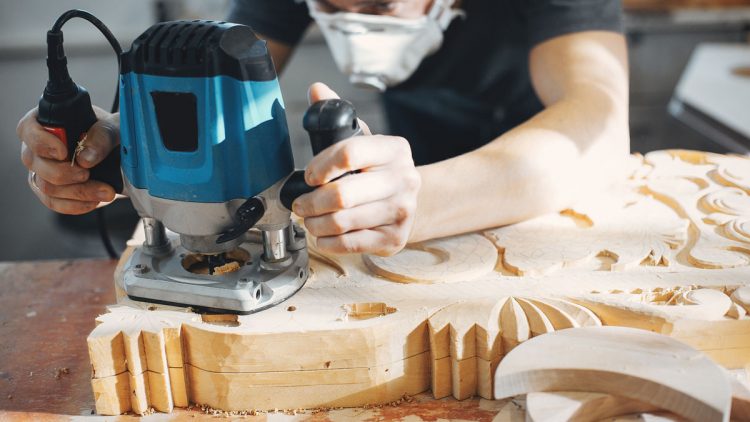How To Use A Router
Routers are a type of power tool that is mostly used in joinery, woodworking, and carpentry to make things like cabinets and furniture. They are most often used for working with wood, but they can also be used on plastic and some other soft materials.
What Does A Router Do?
A router spins quickly to cut, shape, and trim wood to make edges and corners that are perfectly finished. Routing a piece of work improves its overall design.
Most of the time, they are used to make patterns in wood, like rounding off the edges of worktops, drawing on picture frames and cabinets, and a lot more. In this way, they raise the bar for plain wooden edges.
You might not believe it, but wood routers do more than just cut and shape wood. You can make dadoes, rabbets, and other shapes.
Step by Step Instructions on How to Use a Router
Step 1: Make sure the tool is off and turn it over so that the router bit fits.
Step 2: Change the depth of your router based on the type of router you have and the job you need to do.
Step 3: If your router has more than one speed, set it to the right speed for the job.
Step 4: If you can, hook up a dust extractor.
Step 5: For a smoother process, start cutting in the opposite direction of the plane’s spin.
Step 6: For hand-held routers, feed from left to right.
Step 7: Feed from right to left on router tables
How to tell a router what its depth is
You can change how deeply the router cuts into the material and how much material is removed by changing the depth. The way you do this will depend on the type and brand of router you have, but it’s pretty simple and will be explained in your manual. If you want to change the depth of a plunge router, all you have to do is use the depth stop scale to move the tool to the right depth for your cut. Fixed base routers stay at the same height during the whole cut. The trimmer base is all that is needed to change them.
How to use a router for wood
If your router has more than one speed, the next step is to set it to the right speed for the job. You can find this in the instructions. After that, you can connect it to your dust extractor if it can do that. Since routing can make a lot of dust, this is always a good idea if you plan to do it a lot. The router is now ready to be turned on and used.
Since router bits spin in a clockwise direction, it’s best to go against the clock when routing the top of a piece of work. The router is coming at you from this angle, which gives you more control and accuracy. The wood does tend to chip when this method is used, though. This could happen, so go backwards and clockwise for a few inches. For edges, move the router the other way from the way the bit is spinning (see below).
For hand-held routers, feed from left to right.
When feeding router tables, go from right to left.
You should always go the opposite way of the cutter’s spin. The bit will be able to glide more easily, which will make the process go more smoothly and give you the best results.
If you have never used a router before, you can always try it out on some scrap wood first. A parallel guide is an important part of most routers that makes sure plunge cuts are perfectly straight.
Which router bit to use
There are a lot of different kinds of router bits and cutters out there. To get clean routed edges, you need to use a sharp, good router bit.
Here is a list of some of the most common router bits and what they are used for. You can also look at the diagram to get a better idea of the cuts that these router bits will make.
Types of router bits:
One type of router bits that is used a lot is the straight router bit. They cut the material straight through to hollow it out so that grooves or dadoes can be made. People also like to use straight router cutters to carve letters, numbers, and other shapes into wood. This is where your parallel guide will come in handy for making straight cuts. To engrave, just draw the shape, letter, or number you want to use on the wood and then use your router to follow it.
Straight Router Bits
Bits for Rabbeting: At Toolstop, we call rabbet router bits “RB Router Bits,” so keep an eye out for that in the names of our products. With rabbeting bits, you can make cuts that are straight, vertical, or horizontal. Rather than making intricate designs to finish off wood, they are more often used to make spaces for other things to fit in. For example, picture frames use rabbet cuts so that the glass can fit inside the frame without any gaps.
Bits for Rabbeting
Flush Trim Router Bits: These router bits are used to line up the edges of two pieces of material so that they are flush. For instance, if you need to glue two pieces of wood together, flush trim router bits will make sure that they have the same edge and fit together perfectly. This method is often used on surfaces that are veneered.
Trim Router Bits That Are Flush
Chamfer Router Bits—The chamfer router bit is another very common type of router bit. With the right bit, these router cutters can make bevel edges at a certain angle. They can also be used to change the edge of your work piece.
Chamfer Bits for Routers
Round Over Router Bits: These bits work a lot like chamfer router bits, but they can be used for much better designs. With these router bits, you can give a piece of material decorative and stylish edges that really make it stand out. To help you get different edges, they come in different styles, such as round over bits and cove router bits.
Woodworking Supplies Mesa by Timber Woodworking
Timber Woodworking offers hardwoods in Mesa, Arizona. We specialize in woodworking tools, equipment, and supplies for commercial woodworking cabinet shops or furniture manufacturers as well as the home shop hobbyist. Contact us today, or call if you should have any questions.

